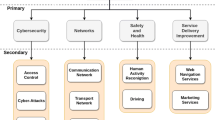Abstract
Modern mobile networks, such as GPRS and UMTS, support wireless data applications. One successful example is the ever popular i-Mode in Japan. Wireless data services (wireless Internet) become more important as more and more customers of handheld devices enjoy the convenience of the ubiquitous computing. To improve the effective wireless data access, the time-to-live (TTL) management for data entries becomes important due to its use in effective caching design. In this paper, we study three TTL prediction schemes and investigate the effects of the inter-update time distribution on the wireless data access. Performance analysis is carried out via simulations as well as analytical modeling. We expect our results will be useful for the future wireless data access systems, in which transmission power for mobile devices is more limited.
Similar content being viewed by others
References
Apache 1.3, HTTP Server Document, http://www.apache.org (2000).
S. Asmussen, Matrix-analytic models and their analysis, Scandinavian Journal of Statistics 27(2) (2000) 193–226.
P. Cao and S. Irani, Cost-aware WWW proxy caching algorithms, in: Proc. Usenix Sympos. Internet Technologies and Systems (1997).
Y.-M. Chuang, T.-Y. Lee and Y.-B. Lin, Trading CDPD availability and voice blocking probability in cellular networks, IEEE Network 2(12) (1998) 48–54.
Y. Fang and I. Chlamtac, Teletraffic analysis and mobility modeling for PCS networks, IEEE Transactions on Communications 47(7) (1999) 1062–1072.
S. Helme, The new generation, Mobilecommunications Asia (January 2000) 12–16.
G. Latouche and V. Ramaswami, Introduction to Matrix Analytic Methods in Stochastic Modeling (SIAM, Philadelphia, 1999).
Y.-B. Lin and I. Chlamtac, Wireless and Mobile Network Architectures (Wiley, 2001).
P.P. Maglio and R. Barrett, Intermediaries personalize information streams, Communications of ACM 43(8) (2000) 68–74.
M. Naldi, Measurement-based modelling of Internet dial-up access connections, Computer Networks 31(22) (1999).
Omnisky, http://www.omnisky.com (2000).
J.E. Pitkow, Summary ofWWWcharacterizations, Computer Networks and ISDN Systems 30(1-7) (1998).
S.M. Ross, Stochastic Processes (Wiley, 1996).
J. Shim, P. Scheuermann and R. Vingralek, Proxy cache algorithms: design, implementation, and performance, IEEE Transactions on Knowledge and Data Engineering 11(4) (1999).
Squid 2.3, Internet Object Cache Document, http://squid. nlanr.net/Squid (2000).
Author information
Authors and Affiliations
Rights and permissions
About this article
Cite this article
Fang, Y., Haas, Z.J., Liang, B. et al. TTL Prediction Schemes and the Effects of Inter-Update Time Distribution on Wireless Data Access. Wireless Networks 10, 607–619 (2004). https://doi.org/10.1023/B:WINE.0000036462.21300.25
Issue Date:
DOI: https://doi.org/10.1023/B:WINE.0000036462.21300.25




